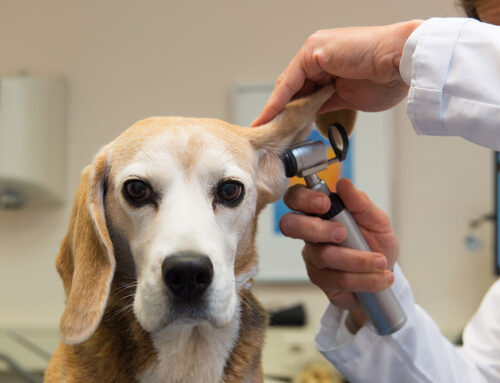At the start of a brand new year, we make resolutions that often include improving our health and wellbeing. By February, those good intentions are often running out of steam. If you’ve made promises to yourself about getting into shape, why not pair up with your pet and tackle those health goals together?
To help keep you successful, Palm City Animal Medical Center has composed a list of the top four ways to easily add years to your pet’s life—and improve their quality of life every day.
#1: Maintain your pet’s routine veterinary care
Preventive veterinary care is instrumental in providing your pet with a long and healthy life. Preventive (i.e., wellness) care, as the term suggests, is all about avoiding illness, disease, and injury. While bringing your healthy pet to the veterinarian may seem unnecessary, pets are masterful at hiding how they feel. Our veterinarians can identify early signs or trends that suggest health problems, and an early diagnosis leads to a more successful—and affordable—cure or management.
Common preventive care services include:
- Physical exam — With a nose-to-tail assessment of all body systems, our skilled veterinarians can detect pain, inflammation, irritation, and body condition changes such as muscle or weight gain or loss.
- Vaccinations — Vaccines protect your pet against infectious diseases and viruses.
- Screening tests — Annual heartworm, tick, and fecal testing can identify infectious and harmful diseases (e.g., heartworm disease, Lyme disease) and the presence of circulating parasites.
- Blood work — Yearly blood work provides invaluable insight into your pet’s organ function, and can pick up changes, such as kidney disease, long before they impact their outward health.
- Parasite prevention — Year-round flea, tick, and heartworm prevention plans are critical for every dog and cat. These preventives also protect your home and family from zoonotic diseases that can pass from pets to people.
#2: Keep your pet at a healthy weight
Weight management is essential to your pet’s overall health and longevity. In one well-known lifetime study by Purina, dogs fed a portion-controlled diet lived nearly two years longer than their counterparts fed ad lib—imagine how many walks, belly rubs, and happy memories can take place in two years!
Overweight pets suffer from increased pressure on their joints, resulting in earlier onset arthritis, and other painful mobility issues. Obese pets are also at a higher risk for cancer, orthopedic injuries (e.g., cruciate ligament rupture, hip dysplasia), endocrine disorders (e.g., diabetes), kidney issues, respiratory problems, and inflammatory skin conditions.
Help your pet achieve or maintain a healthy body weight by:
- Learning how to assess body condition for dogs and cats
- Feeding a nutrient-dense complete and balanced diet in proportion to their calorie needs
- Eliminating table scraps and feeding treats that make up no more than 10% of their daily calorie consumption
- Providing daily physical exercise suitable for their age, ability, and current weight
Need help selecting a new pet food, or designing a safe weight loss program for your dog or cat? Schedule a consultation at Palm City Animal Medical Center.
#3: Pay attention to your pet’s dental health
Periodontal (i.e., dental) disease affects 80% of dogs and 70% of cats by age 3. This condition is more than bad breath and unsightly tartar—periodontal disease is severely painful, and can lead to compounding health effects, including:
- Gingivitis (i.e., inflamed and sore gums)
- Plaque and tartar accumulation
- Gum loss
- Tooth fracture or loss
- Erosion of tooth root, structure, or surrounding bone
- Organ damage, including kidney, liver, and heart damage, from excessive oral bacteria circulating in the bloodstream
Your pet’s dental health should be evaluated yearly at their wellness exam, and dental cleanings under anesthesia should be scheduled per your veterinarian’s recommendation. Anesthetized cleanings may sound frightening, but anesthesia is necessary to ensure your pet is comfortable, relaxed, and still during the cleaning, X-rays, and treatment.
Implementing a dental care home plan can also push back against periodontal disease. Spending a few minutes per day on toothbrushing, and feeding a Veterinary Oral Health Council (VOHC)-approved dental diet, treats, or chews, can help reduce daily plaque accumulation on each tooth’s surface. VOHC-approved water additives are another effective management tool for pets who prefer a hands-off approach.
#4: Provide your pet with regular exercise and training

Behavior problems are the number one reason why pets are surrendered to shelters, where many run out of time and are euthanized. Proper physical and mental exercise, as well as dedicated and continual training—including socialization and basic manners—are essential to ensure your pet can live safely and successfully in your home for their natural life.
Because many behavioral problems, including destructive and obsessive-compulsive habits, arise from lack of exercise, ensure your pet receives daily physical exercise (e.g., walks, fetch, playing with toys) and mental stimulation (e.g., training, puzzle feeders, interactive toys). Paired with early socialization and instructions from a positive reinforcement trainer, your pet will grow into a polite companion rather than a rowdy roommate.
The small steps you take today toward your pet’s long-term health will pay dividends down the road. The same way you establish your own new habit, consider your pet’s current routine and how you can add new healthy rituals—can you walk your dog to the bus stop rather than drive? Use a dental water additive to reduce your cat’s plaque and tartar? Or, contact Palm City Animal Medical Center, and schedule your pet’s wellness services. Together we can make 2022 the year of more years for your pet.








Leave A Comment